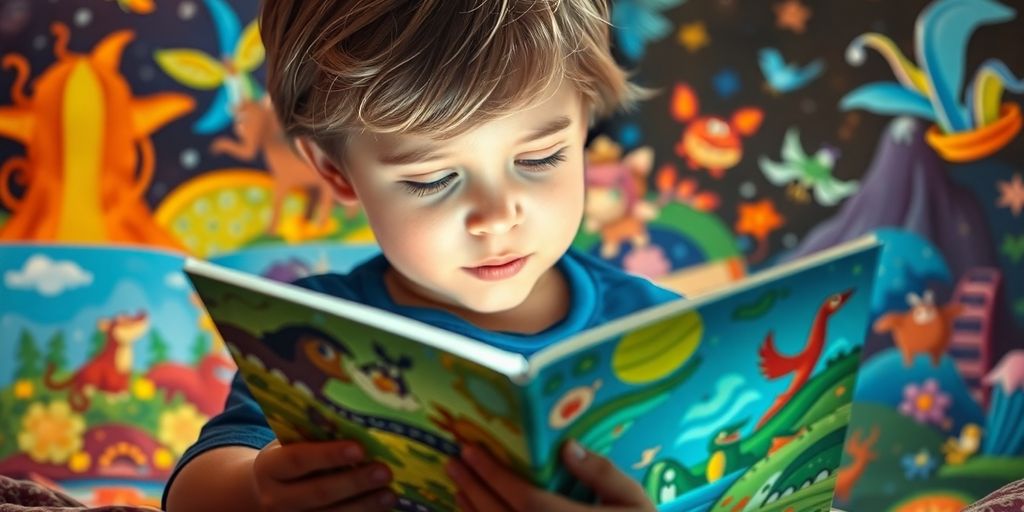Storytelling has always been a big part of our lives, right? From the tales our grandparents told us to the books we read growing up, stories shape how we see the world. Now, AI is stepping into the game, making storytelling for kids more exciting and personal than ever before. Imagine a world where every child can have a story tailored just for them, with characters and adventures that speak to their unique interests and dreams. That’s what AI-powered storytelling is bringing to the table, especially for young readers.
Key Takeaways
- AI is changing how stories are made, making them more fun and personal for kids.
- Kids can now enjoy stories that are just right for their age and interests.
- AI helps create stories that include everyone, showing different cultures and voices.
- Stories can be interactive, turning reading into a fun game with quizzes and puzzles.
- AI tools give writers new ways to be creative, helping them come up with fresh ideas.
The Evolution Of Storytelling In The Digital Age

From Oral Traditions To AI
Storytelling has been with us since the dawn of time. It started with tales passed down orally, moving to written words, and now, with the rise of AI, we’re seeing a new chapter unfold. Digital stories have emerged as a modern form of storytelling, blending traditional narratives with cutting-edge technology. AI tools like the AI Children’s Book Maker are now enabling creators to craft stories that not only entertain but also engage young readers in ways we never thought possible.
The Role Of Technology In Storytelling
Technology has always played a role in how stories are told and shared. From the printing press to the internet, each leap forward has expanded the reach and impact of storytelling. Today, AI is pushing those boundaries even further. With AI, stories can be personalized and adapted to suit individual preferences, making each reading experience unique. This transformation is empowering authors and readers alike, offering new ways to connect with stories.
Transforming Children’s Literature
Children’s literature is undergoing a transformation thanks to AI. Imagine books that adjust their plotlines based on a child’s interests or stories that evolve as the child grows. This isn’t just a dream—it’s happening now. AI tools are helping to create stories that are not only engaging but also educational, catering to the developmental needs of young readers. This shift is making reading more interactive and fun, encouraging kids to explore the world of books with renewed enthusiasm.
As we continue to embrace digital storytelling, we’re not just changing how stories are told; we’re reshaping the very nature of storytelling itself. This evolution is opening doors to new possibilities, making storytelling a dynamic and ever-evolving art form.
AI-Powered Story Generation Techniques

Natural Language Processing Explained
AI stories have become a reality thanks to natural language processing (NLP). This tech helps computers understand and create human language. Imagine a story generator that takes your input—a title, maybe a theme—and spins it into a tale. NLP does the heavy lifting here. It analyzes your words and crafts a narrative that feels just right for kids. It’s like having a storytelling buddy who knows exactly what you’re thinking.
Machine Learning In Storytelling
Machine learning is the secret sauce behind AI-powered storytelling for children. These algorithms learn from tons of data, getting better at creating stories over time. They can pick up on patterns, like how characters usually act or what plot twists keep kids on the edge of their seats. With machine learning, each story is a little smarter, a little more engaging than the last.
Creating Engaging Narratives
Creating engaging narratives is no small feat, but AI makes it look easy. AI crafts stories that are colorful, exciting, and tailored to young readers’ tastes. Whether it’s a bedtime tale or an adventure under the sea, the story generator ensures each narrative is unique. With personalized AI stories for learning, kids get a reading experience that’s both fun and educational. It’s storytelling with a twist of technology, offering customized storytelling with artificial intelligence24 that keeps kids coming back for more.
AI storytelling is like a magic pen that brings imagination to life. It listens, learns, and writes, making stories that are as unique as the children who read them. This isn’t just about telling stories—it’s about creating worlds.
Personalization And Customization In Storytelling

Tailoring Characters And Settings
In the world of storytelling, especially for kids, having the ability to tweak characters and settings can make a huge difference. Imagine a tale where the hero looks just like your child or a setting that mirrors your neighborhood. This is what Storytime offers. Personalized narratives like these not only captivate young minds but also foster a deeper connection to the story. Kids can see themselves in the adventures, making the experience more immersive and relatable.
Unique Plotlines For Every Reader
No two kids are the same, so why should their stories be? With AI-driven tools, every child can have a unique plotline. This isn’t just about changing a few names; it’s about crafting a narrative that resonates with their interests and imagination. Parents and educators can input preferences, and voilà, a story unfolds that’s as unique as the child reading it. This level of story customization keeps young readers engaged and eager to see what happens next.
Empowering Authors With Creative Control
For authors, these tools are a game-changer. They can mix and match elements to create something truly original. While AI provides the framework, authors have the freedom to infuse their creativity, ensuring the story aligns with their vision. It’s like having a co-writer who suggests ideas but lets you decide what fits best. This collaboration results in stories that are not only innovative but also deeply personal.
With the rise of AI in storytelling, we’re not just telling stories; we’re crafting experiences tailored to each reader, making every tale a personal journey.
Age-Appropriate Content For Young Readers
Catering To Different Developmental Stages
Creating stories that match the developmental stages of children is key to fostering a love for reading. For the little ones, bedtime stories often spark imagination and comfort. As they grow, stories can introduce more complex themes and characters, helping in their reading progress. Tailoring content to fit these stages ensures that kids remain engaged and interested.
Ensuring Engagement And Enjoyment
To keep young readers hooked, stories need to be fun and interactive. Consider adding puzzles or quizzes related to the story, which can make reading a more dynamic experience. This approach not only makes the reading session enjoyable but also aids in reading comprehension. Here’s how you can make it engaging:
- Introduce relatable characters and settings.
- Use humor and adventure to keep the narrative lively.
- Include interactive elements like choices or mini-games.
Educational Value In Storytelling
Stories are a great way to introduce educational concepts without making them seem like a chore. By weaving lessons into the narrative, kids can learn while they enjoy. Whether it’s a tale about friendship or a journey through history, the educational value can be immense. Books that combine fun with learning can significantly boost child development.
Reading is not just about the words on a page; it’s about opening doors to new worlds and ideas. For children, each story is a stepping stone in their journey of discovery and growth.
Fostering Inclusivity And Diversity
Creating Stories For Diverse Audiences
In today’s world, it’s more important than ever for kids to see themselves reflected in the stories they read. Diverse characters and backgrounds in children’s literature help foster empathy and understanding. AI tools now enable authors to easily create stories that include a wide range of cultures, experiences, and perspectives. This means kids from all walks of life can find characters who look like them or share similar experiences, making reading a more relatable and enriching experience.
Promoting Cultural Awareness
Books are a window to the world, and AI storytelling is opening that window wider than ever. By incorporating elements from various cultures, these stories can teach children about different traditions and ways of life. This not only broadens their horizons but also helps them appreciate and respect the diversity around them. AI can assist in accurately representing cultural nuances, ensuring that stories are respectful and enlightening.
Empowering Underrepresented Voices
AI technology is also giving a platform to voices that have historically been underrepresented in children’s literature. By making it easier to publish diverse stories, AI is helping to level the playing field, allowing more authors from varied backgrounds to share their unique perspectives. This democratization of storytelling means that more children can see themselves as potential authors, inspiring the next generation of storytellers.
Interactive Learning Through Storytelling
Gamification Of Reading Experiences
Interactive storytelling is changing how kids learn through stories. By turning stories into games, kids can have fun while learning. These interactive bedtime stories for kids use games to make reading exciting and engaging. Imagine a story where kids can choose what happens next or solve puzzles to move the story forward. This makes the reading experience not just fun but also a way to learn new things.
Incorporating Quizzes And Puzzles
Educational AI stories for children often include quizzes and puzzles. These are not just fun but also help kids think and learn. For example, a story might pause and ask a question about what just happened, encouraging kids to remember and understand the story better. Puzzles can also be part of the narrative, making kids solve them to find out what happens next. This kind of interactive storytelling is a great way to use stories as learning tools.
Enhancing Knowledge Retention
Interactive storytelling helps kids remember what they learn. By being part of the story, kids are more likely to remember the plot and the lessons it teaches. Educational stories2 that include interactive elements make learning more memorable. Kids storytelling becomes a powerful tool for education, helping them retain knowledge in a fun and engaging way.
Interactive storytelling isn’t just about telling a story. It’s about making kids part of the story, helping them learn and grow in a way that’s fun and memorable. With digital learning tools like Storypod, children engage with stories in a way that enhances their learning and development.
Nurturing Creativity And Imagination

Inspiring Young Authors
Every kid has a story to tell, and with the right tools, they can bring those stories to life. StorybooksByMe is a great example of how technology can empower children to create their own personalized storybooks. It’s not just about writing; it’s about seeing their ideas come to life with illustrations and characters they choose. This process not only boosts their confidence but also shows them that their imagination has no limits. Kids can explore different genres, experiment with narrative styles, and even tackle complex themes, all while having fun.
Encouraging Artistic Expression
Art isn’t just about painting or drawing; it’s about expressing oneself. Through storytelling, kids can explore different forms of artistic expression. They can create vivid worlds with words, craft unique characters, and develop plots that reflect their personal experiences and dreams. This kind of creative freedom is crucial for developing their own artistic voice. Plus, when kids see their stories published, whether digitally or in print, it reinforces their sense of accomplishment and encourages further exploration of their creative talents.
Unlocking New Storytelling Possibilities
The digital age has opened up countless possibilities for storytelling. With AI-powered tools, young authors can now create interactive stories that engage readers in new ways. Imagine a story where readers can choose the path the characters take, or a book that includes puzzles and quizzes to deepen the reader’s engagement. These innovations not only make reading more fun but also help kids develop critical thinking skills. By integrating technology with traditional storytelling, children learn to appreciate both the art of narrative and the potential of digital creativity.
In a world where technology often feels overwhelming, it’s refreshing to see it being used to nurture creativity and imagination in children. By blending storytelling with digital tools, we’re not just creating new authors; we’re inspiring a generation of thinkers and dreamers who see the world not just as it is, but as it could be.
Conclusion
So, there you have it. AI is changing the game for kids’ books, making them more fun and personal. It’s like having a magic wand for storytelling. Writers can whip up tales that are just right for every kid, and kids get to dive into stories that speak to them. It’s a win-win. Plus, with all the cool tech, books are more than just words on a page now—they’re an adventure. This AI stuff is just the start, and who knows where it’ll take us next. But one thing’s for sure, it’s making reading a whole lot more exciting for everyone.
Frequently Asked Questions
What is AI storytelling for kids?
AI storytelling for kids uses computer programs to create fun and exciting stories. These stories can be personalized and are designed to capture the imagination of young readers.
How does AI create stories?
AI uses special techniques called natural language processing and machine learning to understand and generate stories based on ideas or themes provided by users.
Can AI stories be customized?
Yes, AI stories can be customized. Authors can change characters, settings, and plots to make each story unique and fit their vision.
Are AI-generated stories suitable for all ages?
AI-generated stories can be tailored to different age groups, ensuring they are appropriate and engaging for various developmental stages.
How does AI storytelling promote diversity?
AI storytelling promotes diversity by allowing authors to create stories with diverse characters and themes, helping children learn about different cultures and perspectives.
What makes AI storytelling interactive?
AI storytelling can include interactive elements like quizzes and puzzles, making reading more engaging and fun for children.



